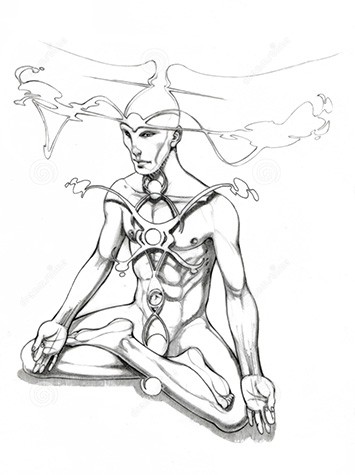The system of chakras in the yogic tradition describes seven energy centers along the “shushumnanadi”, which roughly corresponds to the spine anatomically. These energy centers cannot be observed physically within the body as they exist on an energetic level.
“Chakra” means wheel and each chakra has an associated shape and color. The lowest chakra, located at the base of the spine is the Root chakra. It is red in color and has a square shape. It governs our sense of trust, belonging to a tribe or community and fulfillment of basic needs like food and shelter. Hip stretches and standing poses activate and balance the Root chakra.
The Sacral chakra is located at the pelvis or sacrum. It is called the “sea of sweetness” as it governs sexuality, reproduction and creativity. It is orange in color and has six petals like a flower. The third chakra is the Solar Plexus chakra and it is yellow in color with 12 petals like the shining sun. It governs our sense of self-confidence and will-power. It is the seat of the ego.
The Heart chakra is the center of the chakra system. It is the meeting point between our lower instincts and our higher sensibilities. It links earth to heaven. The shape associated with the heart chakra is two triangles that form a star shape. The color associated with the Heart chakra is green. This chakra governs our connection to others and relationships.
The Throat chakra is light blue in color and governs communication and self-expression. The Third Eye chakra located at the forehead is responsible for our mental functions such as memory, intellect, imagination and sleep. It is dark blue in color and has two petals, the overall shape resembling an eye. The highest chakra is the crown chakra and its associated color is purple (or white). It has a thousand petals and represents our connection to the higher being or the Divine.
Book Review: “The Teaching of Buddha” published by Bukkyo Dendo Kyokai.
“The wise man learns to meet the changing circumstances of life with an equitable spirit, being neither elated by success nor depressed by failure. Thus one realizes the truth of non-duality.”
After traveling far and wide for many years seeking to find a solution for the ills of the world – disease, old age, and death – the young prince finally came to sit under a tree, vowing not to leave until he attained Truth. Through this practice of sitting meditation and learning to still the mind from its constant chatter, the prince became “The Perfectly Enlightened One” or “Buddha”. Buddhism is practiced in many Asian countries like India, China, Japan, and Thailand.
Noha Sayed Alahl is a certified Hatha Yoga teacher and has been practicing Yoga since 2002.
Noha.sayedalahl@gmail.com
01121030099

